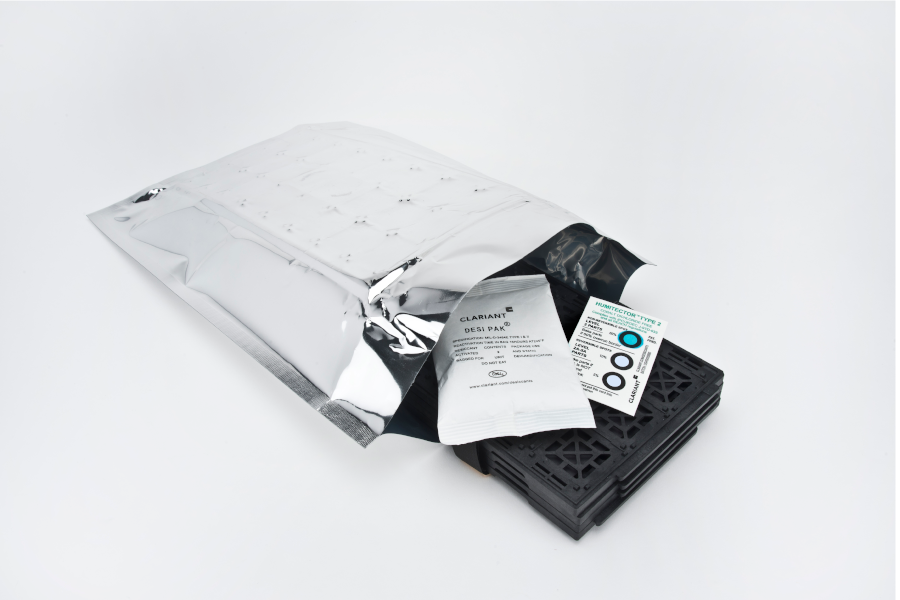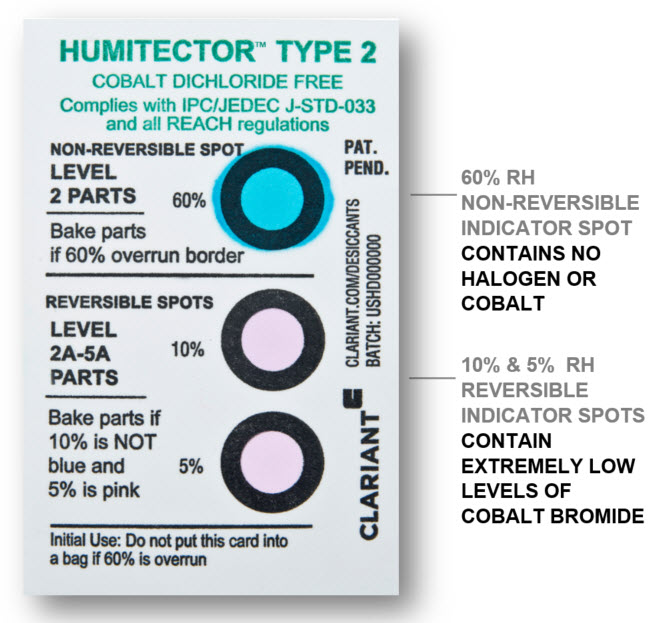Why are Halogen-Free Humidity Indicator Cards Important?
A Sustainable Alternative
Reducing the overall use of chemicals in our products is important to Clariant. We are continuously striving to improve the sustainability of our products, including our Humidity Indicator Cards (HICs).
What is the concern about halogens? Why is there an industry push for halogen-free products?
The term “halogen” describes a group of five elements on the periodic table: fluorine (F), chlorine (Cl), bromine (Br), iodine (I), and astatine (At). All are toxic to some degree, but two of these elements — bromine and chlorine — are the most commonly used. Therefore, they are the focus of most concern to companies who use humidity indicator cards in packaging for moisture-sensitive electronic devices, components, and circuit boards. Here’s why.
Chlorine and bromine have been the principal elements in two types of flame retardants added to plastics used as substrates, laminates and insulating materials in printed circuit boards for electronic devices. As the name implies, flame retardants have made circuit boards and electronic devices much less likely to ignite and therefore much safer to use. Flame retardancy standards for plastics are detailed in a series of global product-safety standards, including UL 94; IEC 60607, 60695-11-10 and 60695-11-20; and ISO 9772 and 9773.
Concern about the presence of halogenated flame retardants (HFRs) has risen largely because of how electronic devices (e.g., old computers, cell phones, TVs) are disposed of or recycled. The goal of electronics recycling is, of course, to recover valuable materials, mainly metals. However, improper and unregulated recycling methods — the kind most likely to be used in poorer countries where electronic trash is recycled for profit — can release trace halogens that are known to cause health problems. For example:
- Burning or melting plastics off circuit boards can expose recyclable metals. However, uncontrolled burning of HFR-treated plastics can also release corrosive or toxic gases.
- Similarly, crushing or grinding plastic to release metals may also release trace halogen residues into air or water.
In response to these environmental concerns, the electronics industry has adopted very strong policies to reduce or eliminate the use of halogens. Industry standards bodies like the Joint Electron Device Engineering Council (JEDEC), International Electrotechnical Commission (IEC) and Japan Printed Circuit Association (JPCA) have supported these policies by developing standards that define “low-halogen” and “halogen-free” products. Industry concern about halogens is so intense that many companies are demanding that even supplies and packaging that are not part of the finished electronic product meet the same stringent halogen-related standards.
Why are halogen-free humidity indicator cards important?
Humidity indicator cards are small cards that indicate whether a moisture-sensitive electronic component has been exposed to a harmful level of moisture. Humidity indicator cards, together with desiccant packets, are sealed with moisture-sensitive surface mount devices (SMDs) inside “dry packs” that protect SMDs from the time they are made until they are actually installed into a larger electronic device as part of the device manufacturing process. The use of humidity indicator cards as part of protective packaging is a well-defined industry standard.

Humidity indicator cards indicate the presence (or absence) of moisture using moisture-sensitive spots that change color when moisture exposure has occurred.
For many years, the reactive material in these tiny indicator spots has been a halogen compound, such as cobalt dibromide (CoBr2), copper dichloride (CuCl2) or copper dibromide (CuBr2).
Even though humidity indicator cards are used only in protective packaging, the presence of even small amounts of halogens in some humidity indicator cards makes them subject to the electronic industry’s far-reaching low-halogen or halogen-free standards.
Accordingly, Clariant, the maker of a range of humidity indicators, regularly tests its cards to current industry standards. Tests were recently conducted on its new Humitector™ Type 2 Non-Reversible Humidity Indicator Cards according to BS EN 14582, a widely accepted halogen test method. Test results demonstrate that Clariant’s Humitector™ Type 2 HICs meet the tough halogen-free requirements (≤900 ppm of Br or Cl, ≤1500 ppm Br + Cl combined) contained in IEC-61249-2-21 and IPC 4101-B.
Let’s not forget about cobalt
To further improve the sustainability of our Humitector™ Type 2 Humidity Indicator Cards, we have drastically reduced the cobalt content of these cards to less than 300 ppm.
Although reducing and limiting the amount of cobalt used in our products is not an industry requirement, Clariant has taken this step to continue our commitment to reducing the use of chemicals whenever and wherever possible. This improvement means that our new Type 2 cards no longer contain any cobalt or halogen in the 60 percent RH spot. As a result, the overall cobalt content of the Type 2 Humidity Indicator Card has been reduced by more than 50 percent compared to the Type 1 card.

Clariant remains committed to maintaining the precision and accuracy of all of our relative humidity indicators so that device makers are assured an excellent quality of our products. At the same time, these actions show our commitment to supporting electronic industry initiatives for halogen-free materials and continued reduction in cobalt content.
Call us, Email us, or contact us above to learn more about humidity indicator cards and desiccants for use in dry packing!

